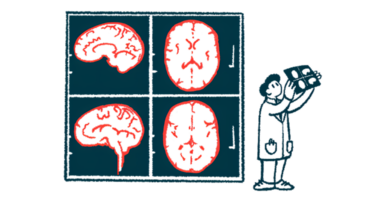Molecular mechanisms help drive microglia problems in brain in MS
Exposure to cellular carcasses may be key driver, study finds

Disease-associated inflammatory activity of microglia — a type of immune cell with a central role in the development of multiple sclerosis (MS) — is driven in part by molecular mechanisms that are activated when microglia try to clear the corpses of dead myelin-making cells.
That’s according to a new study done in mice and cell models that researchers say could lead to novel strategies for protecting MS patients from potential brain damage.
“What it means for people with MS is that if their brains’ immune cells were to become toxic under certain conditions, then this research could open up a new way to protect their brains against damage,” Jason Plemel, PhD, a professor at the University of Alberta, in Canada, and co-author of the study, said in a press release. Plemel said the goal is to “maybe make neurotoxic microglia less injurious.”
The study, “Single-cell microglial transcriptomics during demyelination defines a microglial state required for lytic carcass clearance,” was published in Molecular Neurodegeneration.
Investigating molecular mechanisms of microglia in the brain
Multiple sclerosis is caused by inflammation in the brain and spinal cord, which results in a loss of myelin — a fatty covering that wraps around nerve fibers and helps them send electrical signals. This neurological damage ultimately drives the symptoms of MS.
Many different types of immune cells play a role in the inflammatory attack that drives myelin loss in MS. One key type of immune cells are microglia, which are the main resident immune cells in the brain. Normally, microglia are critical in the brain for protecting it from infection; they also act as a sort of cellular garbage collectors in helping to clear molecular debris.
In MS and other neurological diseases, these cells can become dysregulated. However, the specific mechanisms underlying such problems remain incompletely understood.
Now, a team of scientists in Canada conducted tests in a mouse model to better understand the role of microglia in demyelination, or myelin loss.
Our lab is studying the yin and yang of microglia — we’re really trying to understand if and how the microglia become neurotoxic.
“We know that under certain conditions the microglia are profoundly important for regeneration — and we also know that under other conditions they may have seemingly neurotoxic properties,” Plemel said, noting that researchers are trying to find ways minimize damages.
“Our lab is studying the yin and yang of microglia — we’re really trying to understand if and how the microglia become neurotoxic,” Plemel said.
Here, the team specifically used a mouse model in which the animals are fed cuprizone, a toxic chemical that induces myelin loss in the brain. Prior research had shown that in mice engineered to have no microglia, cuprizone does not induce myelin damage, suggesting these cells are necessary for myelin loss in this model.
“The cuprizone model is ideal for defining brain intrinsic mechanisms of demyelination,” the researchers wrote.
Cell-tracking experiments in this model showed that, as mice started being fed cuprizone and undergoing demyelination, the number of inflammatory microglia in the affected brain regions nearly double. Those findings further highlighted the importance of these cells in myelin loss in this model.
However, when the researchers engineered mice so that their microglia would die a few weeks after starting on cuprizone, myelin loss was not affected.
“Therefore, microglia involvement in demyelination may occur within the first two weeks after the start of dietary cuprizone,” the researchers wrote.
Microglia activity in the brain similar in MS, Alzheimer’s
The team then conducted single-cell RNA sequencing, a type of analysis that allowed them to examine the overall activity of individual microglia on a cell-by-cell basis.
From this analysis, several distinct groups of microglia showing different patterns of genetic activity were identified. But three of these groups were only seen in mice fed cuprizone, implying that microglia in these groups may be dysregulated in a manner that promotes demyelination.
In particular, the scientists found that cuprizone-associated microglia showed genetic profiles that suggested an increase in phagocytosis, or so-called cellular eating, which is the process that microglia use to remove molecular debris.
Cuprizone-associated microglia also expressed higher levels of inflammatory signaling molecules and showed evidence of more oxidative stress — a type of cell damage that occurs as part of inflammation.
In comparing these findings with previously published data in other diseases, the results showed that the genetic activity profile in cuprizone-associated microglia was somewhat similar to the activity of these cells in models of Alzheimer’s disease.
“This tells us that the microglia immune cells present in MS white-matter [brain] injury have similar characteristic states and functions to the ones in Alzheimer’s disease,” Plemel said. White matter is myelin-dense brain tissue.
Treatment with cuprizone is known to lead to the death of oligodendrocytes, the cells mainly responsible for making myelin in the brain and spinal cord. The researchers showed that cuprizone specifically leads to an increase in lytic — also called necrotic — cell death.
In this violent event, the cell is ripped open, spilling out its molecular contents and leaving behind a mess of dead cell parts known as a lytic carcass.
In experiments where microglia were removed a few weeks after starting cuprizone treatment, there were substantially more lytic carcasses in the brain. This suggests that microglia play a key role in removing these dead cells, the researchers said.
In a final set of cellular experiments, microglia were exposed to pieces of dead oligodendrocytes, or bits of broken myelin debris, which induced a change in genetic activity similar to what was seen in the cuprizone-associated microglia.
This suggests that the clearance of these dead cells plays a role in driving inflammatory abnormalities of microglia in MS, the researchers said, noting that further understanding these brain mechanisms may open avenues toward new treatments.







